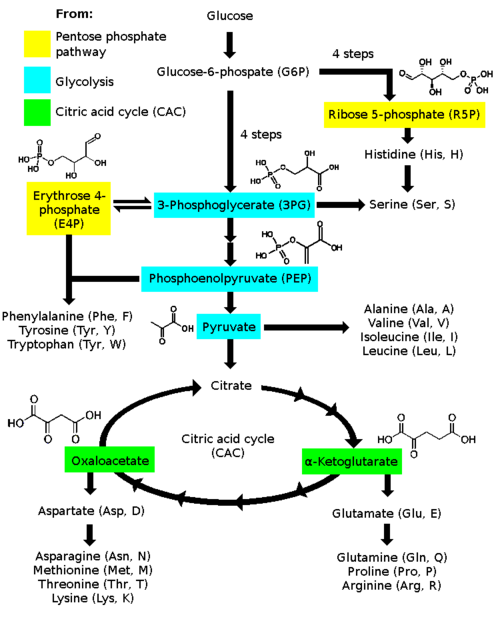Amino acid
Amino acids are organic molecules that serve as the building blocks for proteins. Comprising a central carbon atom to which an amino group (-NH2), a carboxyl group (-COOH), a hydrogen atom, and a unique side chain (often referred to as an "R" group) are bonded, these compounds play a critical role in various biological processes.

Characteristics[edit]

Amino acids have a general structure which consists of a central carbon atom (alpha carbon) bonded to an amino group, a carboxyl group, a hydrogen atom, and a distinct side chain. The properties and activities of each amino acid are determined by its specific side chain.
Classification[edit]
Amino acids can be categorized based on various criteria, including their side chain properties, nutritional requirements, and metabolic fate.
By Side Chain Properties[edit]
- Nonpolar (hydrophobic): Include alanine, valine, leucine, and isoleucine.
- Polar (hydrophilic): Include serine, threonine, and asparagine.
- Acidic: Include aspartate and glutamate.
- Basic: Include lysine, arginine, and histidine.
By Nutritional Requirements[edit]
- Essential amino acids: Cannot be synthesized by the human body and must be obtained from the diet. Examples include lysine, leucine, and valine.
- Non-essential amino acids: Can be synthesized by the human body. Examples include glycine, alanine, and serine.
- Conditionally essential amino acids: Typically non-essential, but under certain circumstances (e.g., disease or stress), their synthesis may be limited. Examples include arginine, cysteine, and glutamine.
Functions[edit]
Amino acids have numerous roles in the body:
- Protein Synthesis: They join together to form peptides and proteins.
- Neurotransmitter Synthesis: Amino acids like tryptophan and tyrosine are precursors to neurotransmitters serotonin and dopamine, respectively.
- Energy Production: Some can be metabolized to produce energy.
- Hormone Production: Certain hormones are derived from amino acids, like thyroxine from tyrosine.
Dietary Sources[edit]
Amino acids are commonly found in various foods, especially:
Deficiency[edit]
A deficiency in essential amino acids can lead to a variety of health issues, including muscle loss, weakened immune function, and growth retardation in children.
See Also[edit]
| Encoded (proteinogenic) amino acids | ||||||||||||||||
|---|---|---|---|---|---|---|---|---|---|---|---|---|---|---|---|---|
|
| Chemical bonds | ||||||||
|---|---|---|---|---|---|---|---|---|
|
| Protein primary structure and posttranslational modifications | ||||||||||
|---|---|---|---|---|---|---|---|---|---|---|
|
| Metabolism: Protein metabolism, synthesis and catabolism enzymes | ||||||||||||||
|---|---|---|---|---|---|---|---|---|---|---|---|---|---|---|
|
Essential amino acids are in Capitals
|
Ad. Transform your life with W8MD's Budget GLP-1 injections from $75


W8MD offers a medical weight loss program to lose weight in Philadelphia. Our physician-supervised medical weight loss provides:
- Weight loss injections in NYC (generic and brand names):
- Zepbound / Mounjaro, Wegovy / Ozempic, Saxenda
- Most insurances accepted or discounted self-pay rates. We will obtain insurance prior authorizations if needed.
- Generic GLP1 weight loss injections from $75 for the starting dose.
- Also offer prescription weight loss medications including Phentermine, Qsymia, Diethylpropion, Contrave etc.
NYC weight loss doctor appointmentsNYC weight loss doctor appointments
Start your NYC weight loss journey today at our NYC medical weight loss and Philadelphia medical weight loss clinics.
- Call 718-946-5500 to lose weight in NYC or for medical weight loss in Philadelphia 215-676-2334.
- Tags:NYC medical weight loss, Philadelphia lose weight Zepbound NYC, Budget GLP1 weight loss injections, Wegovy Philadelphia, Wegovy NYC, Philadelphia medical weight loss, Brookly weight loss and Wegovy NYC
|
WikiMD's Wellness Encyclopedia |
| Let Food Be Thy Medicine Medicine Thy Food - Hippocrates |
Medical Disclaimer: WikiMD is not a substitute for professional medical advice. The information on WikiMD is provided as an information resource only, may be incorrect, outdated or misleading, and is not to be used or relied on for any diagnostic or treatment purposes. Please consult your health care provider before making any healthcare decisions or for guidance about a specific medical condition. WikiMD expressly disclaims responsibility, and shall have no liability, for any damages, loss, injury, or liability whatsoever suffered as a result of your reliance on the information contained in this site. By visiting this site you agree to the foregoing terms and conditions, which may from time to time be changed or supplemented by WikiMD. If you do not agree to the foregoing terms and conditions, you should not enter or use this site. See full disclaimer.
Credits:Most images are courtesy of Wikimedia commons, and templates, categories Wikipedia, licensed under CC BY SA or similar.
Translate this page: - East Asian
中文,
日本,
한국어,
South Asian
हिन्दी,
தமிழ்,
తెలుగు,
Urdu,
ಕನ್ನಡ,
Southeast Asian
Indonesian,
Vietnamese,
Thai,
မြန်မာဘာသာ,
বাংলা
European
español,
Deutsch,
français,
Greek,
português do Brasil,
polski,
română,
русский,
Nederlands,
norsk,
svenska,
suomi,
Italian
Middle Eastern & African
عربى,
Turkish,
Persian,
Hebrew,
Afrikaans,
isiZulu,
Kiswahili,
Other
Bulgarian,
Hungarian,
Czech,
Swedish,
മലയാളം,
मराठी,
ਪੰਜਾਬੀ,
ગુજરાતી,
Portuguese,
Ukrainian


